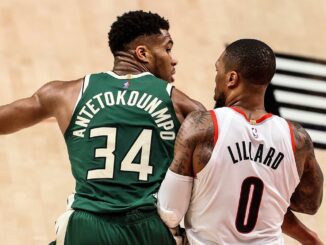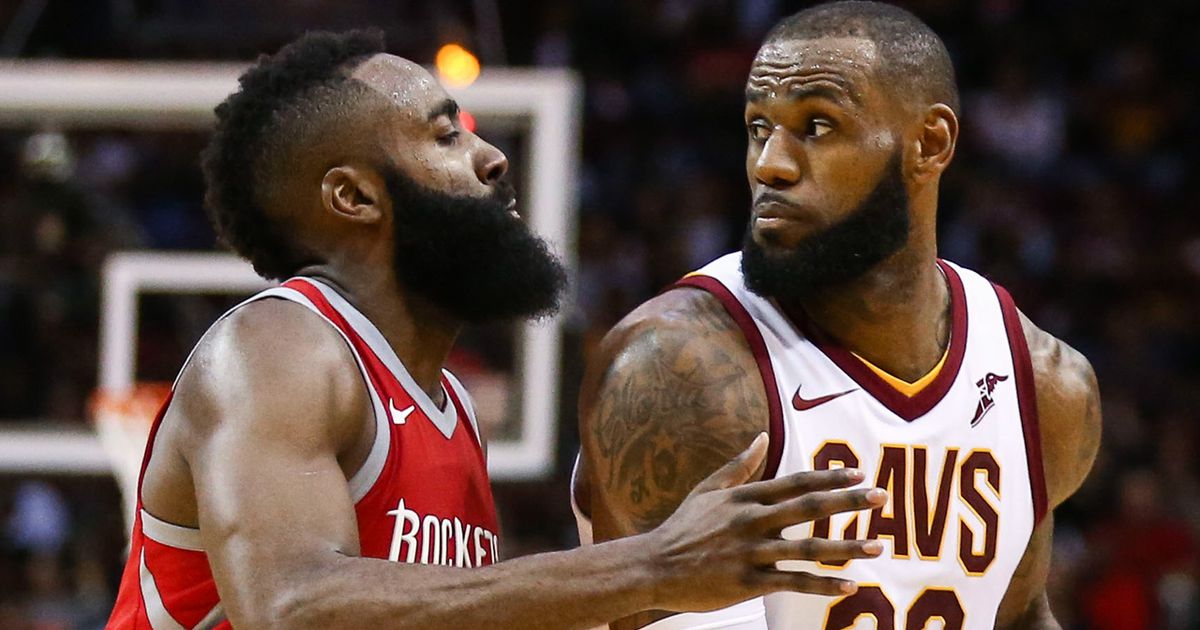
As the calendar turned onto a new year and decade, I had the clever idea to do a 2010s All-Decade Team for the Portland Trail Blazers. As is the usual fate of my clever ideas, a mix of illness, business, and just plain sloth shelved it for the time being.
However, I’m “happy” to report that after meeting up at the Portland Trail Blazers game Saturday night (Damian Lillard is just obscene. I wouldn’t be surprised to see Blazers games get an MA-17 rating after his one-man evisceration of the NBA.), OSN management gave me a swift kick in the nether regions. So now, I’m back to work.
A disclaimer before I dump my list onto the Internet: this is solely my opinion. I’m sure many of you would agree with the obvious choices, but there were a couple of spots I hemmed and hawed over for weeks. It came down to my personal preference, and I might have fudged a couple of traditional positional alignments. It’s cool if you agree and cool if you disagree—just don’t be a jerk about it, please.
Also, I just counted stats from the 2010s exclusively. Stats from the 2019-20 season have been excluded.
Without further preamble, here’s one Blazermaniac’s opinion on the five best and most important players for the Trail Blazers in the 2010s, with a few honorable mentions.
Point Guard: Damian Lillard
Resume: 7 seasons, 4 All-Star Games, First-Team All-NBA (2018), 2 Second-Team All-NBA (2016, 2019), Third-Team All-NBA (2014), 2013 Rookie of the Year, Top 10 in MVP voting three times (4th in 2018), League Leader in Minutes Played (2013), 23.5 PPG, 4.1 RPG, 6.3 APG, 1,506 3PTFGs, 43/37/88 shooting splits, Playoffs (51 G): 25 PPG, 42/37/83, 6 APG, 4.6 RPG, 151 3PTFGs, Multiple Series-winning Three-Pointers (only player in NBA history)
I think I don’t have to explain this one too much; we are talking about the third-greatest player in Trail Blazers history, for Christ’s sake. Because I need to fill space, I’m going to do that anyway.
Lillard’s stats are extraordinary, just like the stats are for every top guard in today’s NBA. With pace at a new high, modern analytics influencing where and when players take shots, and the skills of the players themselves significantly superior to many of their ancestors in the 1960s and 70s, many lead guards are shattering history in their own way. James Harden is averaging scoring numbers not seen since Wilt Chamberlain and Young Michael Jordan, Russell Westbrook was a triple-double machine in Oklahoma City, and Kyrie Irving led the league in Hippie Quotes and Existential Nonsense. Stephen Curry is the best of them all, a defense-contorting menace who is a three-time champion, a two-time MVP, and just might be the greatest shooter to ever pick up a basketball.
Lillard separates himself from most of his peers in several ways. He has unlimited range, a trait he shares with Curry. He also is an incredible leader; watch his interactions with Jusuf Nurkic, Anfernee Simons, and anyone who’s having a rough night, and you’ll see a fascinating combination of a general and a big brother. Dame is the rare superstar who possesses true empathy—he knows what it’s like to fail, to be knocked down and looked down upon. He was no prodigy or overhyped kid, and he knows it. That’s what allows him to stay grounded even as he burns down the best professional basketball league in the world.
Lillard has also shown great affection for the city of Portland, its quirks and vibe, its atmosphere and especially its underprivileged youth. I don’t think the Blazers themselves deserve that kind of loyalty; NBA teams have shown repeatedly that they’re about as loyal to their players as regents are to child kings. Dame’s appreciation for this place, however, will make sure that even if/when he eventually leaves, he’ll still be the Letter O.
Wing: CJ McCollum
Resume: 6 seasons, Most Improved Player Award winner (2016), League Leader in Free Throw Percentage (2017), 17.8 PPG, 3 RPG, 3 APG, 823 3PTFGs, 45-40-84 shooting splits, Playoffs (46 G): 19.6 PPG, 3.8 RPG, 2.5 APG, 44-39-78 shooting splits, averaged 26.4 PPG vs. Denver in 2019 Conference Semifinals including a 37-point game in Game 7
The second obvious choice for this team. I have a love-dislike relationship (hate is too strong a word) with McCollum and his abilities, and lack of stature. His talents are what make him vital to the Blazers’ success, yet the things he doesn’t bring to the table—size, defensive ability, rebounding or playmaking for others—also place a concrete ceiling on Portland’s ability to compete for championships, and no amount of hellfire from Lillard can roast through that ceiling.
On some teams, McCollum would be a perfect second banana or secondary scorer. He can create his own shot with nifty ballhandling, he can play off the ball and space the floor as a deadly three-point shooter, and he is a master of the midrange jump shot—the shot most NBA defenses are constructed these days to concede. His baseline pull-up from 12-15 feet is as automatic a shot as there is, and he gets at least one of those every game.
On other teams, CJ would be a sixth man. His defense isn’t as laughably bad as Lou Williams’ is because he tries, but Lillard’s pride isn’t the only reason why the slightly taller, longer McCollum isn’t checking point guards. His on-ball defense has been lacking, a byproduct of being only six-foot-three in a league stuffed with huge, rangy wing players. But he’s often hidden on the most non-threatening offensive player every night, regardless of size or position; that tells us something about Terry Stotts’ confidence in him.
McCollum also brings little rebounding or ability to create for other players. The lack of rebounding has hurt the Blazers this season, in particular, but his lack of vision has been a drag on Portland’s bench units for years. Last season’s tactic of playing Lillard and McCollum together more often helped, but it simply covered up the fact that McCollum is a poor fit with the Blazers roster.
In an ideal world, McCollum would be coming off the bench as a spark plug scorer, in the vein of Jamal Crawford or Vinnie Johnson. The Blazers’ lack of ability to acquire decent wing players, their need for scoring, and Lillard’s friendship with McCollum will make sure he continues to start—and continues to put a limiter on the Trail Blazers. He’s a very good player, but he isn’t tall enough, well-rounded enough. Not good enough.
Wing: Wesley Matthews
Resume: 5 seasons, League Leader in Games Played (2012, 2014), 15.4 PPG, 3.3 RPG, 2.2 APG, 44-39-82 shooting splits, 826 3PTFGs
I know what you’re saying: “But what about Nicolas Batum?” And I get it. Nico was almost as beloved as Wes was when he was here. I chose Matthews because he was a more consistent scorer, a better shooter, and he never had those invisible games/weeks/months that made me throw my controller in a random direction, causing my dad, my brother, and my dogs to run for cover. Batum came and went like a flaky French ghost. Matthews was always there, giving 100% every game. That stuff matters to me.
I preferred Matthews to Batum in a very thin crop of wing players for the Blazers in the 2010s. His Achilles injury in 2015 torpedoed what was probably Portland’s best chance at a championship that decade—that team was a sneaky dark horse. Just like the undrafted Matthews was.
His signing in 2010 went from being nationally derided (because the Blazers were paying starter money for Brandon Roy’s backup) to being one of the best bargains in Trail Blazer history (once Roy’s knees turned into dust). A prototype 3-and-D guy, Wes made more threes in five seasons than CJ McCollum—a much more gifted scorer—made in six, back when teams didn’t jack 40 threes apiece per game.
After his devasting Achilles rupture, Matthews had a decent couple of seasons in Dallas before bouncing around the league. He’s now riding the pine for the Milwaukee Bucks, on a minimum contract, one foot out of the league. Achilles injuries are a major bummer, man.
Forward: LaMarcus Aldridge
Resume: 6 seasons, 4 All-Star Games, Second-Team All-NBA (2015), Third Team All-NBA (2011, 2014), Top 10 in MVP voting two times (7th in 2015), League Leader in Field Goals Made (2015) and 2-Pt Field Goals Attempted (2013, 2014, 2015), 21.4 PPG, 9.2 RPG, 48% FG%, 80% FT%, Playoffs (28 G): 22.7 PPG, 9 RPG, 45% FG%, 80% FT%, 2014 First-Round Series vs. Houston: 30-11, back-to-back 40-point games in Games 1 and 2 wins on the road
The third and final obvious choice for this team, Aldridge’s early career was defined by Brandon Roy’s ascendance and Greg Oden’s selection first overall in 2007. As the third wheel in what was planned by the Blazers to be a dominant inside-outside combo, then-coach Nate McMillian took pains to make sure Aldridge felt included. Aldridge headed down a path of midrange specialty, spacing the floor for the hypothetical Roy-Oden combo.
Then, Oden’s knees fell apart, ensuring his status as one of the biggest draft busts in both NBA and Blazer history (it would be the biggest draft blunder for any other team, but Portland DID pass on some dude named Michael Jordan in 1984…nothing to see here, Officer…). After that, Roy’s knee cartilage was Vanished away by some foul Harry Potter sorcery, destroying a promising era of Blazer basketball.
However, to his credit, Aldridge made sure that the franchise’s team losses turned into his personal gain. His smooth jump shot, bruising post game, and placid demeanor quickly cemented him as the rock Portland could take refuge on as the storms of injury threatened to capsize the whole organization. After the Blazers developed Matthews and Batum, and drafted Damian Lillard in 2012, Portland quickly became a steady playoff team again behind Aldridge’s steady flow of (points-rebounds) 22-10, 24-9, and 20-11 games.
Looking back on Aldridge’s departure after the 2015 season, I wonder if Lillard’s ascending status made him leery. Dame is not a shy guy, while Aldridge is as quiet and type-B as a multi-time All-NBA player can be. He is/was accustomed to being the Top Guy, yet Lillard’s increased shots, scoring, and profile (both locally and nationally) might have left Aldridge feeling left out and a little scorned. Present-day LMA probably would appreciate a younger player picking up some slack—he seems to play fine with DeMar DeRozen—but Prime LMA probably wasn’t happy with Dame invading his space, both on the stat sheet and as the Top Guy.
So, Aldridge left for San Antonio, where his string of playoff disappointments continued, his 2014 explosion proving to be the exception rather than the rule. Whether he or Lillard will end up as the better all-time player, however, is actually a very interesting conversation. Assuming good health for the twilight of his career, Aldridge is in line to join the 20K-10K Club, or 20,000 career points and 10,000 career rebounds. In the history of the NBA, only 14 players have reached that lofty height; LeBron James will be No. 15 at some point. All 14 guys are in the Hall of Fame.
Aldridge is not thought of as a prolific or dominant player—like Alex English, he was the master of what I like to call the “Quiet 25-Point Game.” (Lillard, on the other hand, is the master of the loud 35-point game with seven threes, two more from 35 feet, and at least one thunderous dunk.) But just like English, the Denver great who’s currently 20th on the NBA’s career points list (Vince Carter just passed him), Aldridge’s numbers will probably get him elected to Springfield someday. I wonder if his bust will be wearing a Trail Blazers jersey….
Center: Jusuf Nurkic
Resume: 2 ½ seasons, 15 PPG, 9.7 RPG, 51% FG%, 70% FT%
Robin Lopez was STRONGLY considered here. I think I flip-flopped about 50 times between them. Nurk gets the nod here because his 171 games were more impactful than RoLo’s 141. He played more games, scored more points, defended at the same rate, outrebounded Lopez by more than two per game…the Bosnian was a better center than our favorite comic book geek/molester of mascots, in what’s been a revolving door at the pivot for the Blazers since Oden went down.
Everyone knows about the devastating broken leg Nurkic suffered last March, but the impact was felt tenfold this season. Hassan Whiteside is a stat-stuffing player that makes about eight questionable decisions per game, and the depth behind the rental has evaporated in an injury-riddled haze. None of that has stopped jolly ol’ Nurk from being the NBA’s tallest, most elegantly coiffed cheerleader this season, though, energetically high-fiving teammates during breaks, joking with “Babo” Lillard during Dame’s rare rests on the bench, and celebrating like he just ran a 100-yard touchdown every time a huge three is made. Seriously, I’m pretty sure Nurk’s calf strain came from trying to outdo Zach Collins’ Celebration Game, and not from drills.
This current season looks to be lost for Portland, despite Lillard’s best efforts. Whiteside is desperately trying to stay relevant in the NBA (not a soul in the Association wants to give him the kind of contract he hoodwinked Pat Riley into doling out in 2016, a move the legendary coach/executive immediately regretted), Nurkic and Collins have been out for much of the year, and the search for wing players is ever-ongoing. Hopefully, next year will bring another season of Apex Lillard, a more experienced young player corps (Nassir Little is making some very heady plays cutting to the basket. He got like five alley-oop dunks against Utah on Saturday), maybe another trade in the offseason, and a healthy Bosnian Bear.
Honorable Mentions
Al-Farouq Aminu: Chief is one of my favorite players ever. He was tasked with stepping into Aldridge’s shoes after he left for Texas, and while there was no way he could replace Aldridge’s production, he capably played his role as a small-ball 4. His willingness to bang with players three-five inches taller than him and 40 pounds heavier than him on a nightly basis will always be appreciated, and his rainbow jumper was so ugly, it looked pretty—until it clanked off the backboard and ricocheted into some poor old lady sitting courtside.
Chief is wasted in Orlando. He’d be a nice role player for a contender. You know, like he was here.
Nicolas Batum: I know I crapped on Batum in this column, but when he was good, he was good, man. We just needed more good out of him, just like Michael Jordan needed more good out of Batum when he grossly overpaid him. A five-year, $120 million contract sounds like a huge amount for a career 11-5-4 guy, and it totally is. Just remember, the Blazers will pay Damian Lillard $50 million and $54 million (!!!) for his age-32 and -33 seasons. Inflation sucks.
Gerald Wallace: I’ll treasure Wallace for three things. One, his incredible toughness. Two, his positional flexibility on defense. Three, for being the guy who Nets GM Billy King traded away their 2012 first-round draft pick for. That pick became Damian Lillard.
God bless stupid people for being stupid, and God especially bless Billy King.
Robin Lopez: He’s now playing on the Bucks with his twin brother Brook. Brook is still the better shooter, even if Robin will always be the more interesting one.
Brandon Roy: Solely for The Brandon Roy Game against the Dallas Mavericks in 2011. That last hurrah for Roy sparked a devastating Dallas run through the entire playoffs, dispatching the rest of the Western Conference, 10-1, before beating the Heatles in six for Dallas’ lone championship. B-Roy gave Rip City one last great moment, then Dirk ripped our hearts out.




